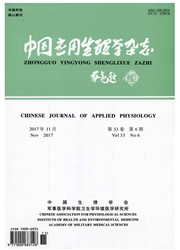

 中文摘要:
中文摘要:
目的:观察乙醇激动乙醛脱氢酶2(ALDH2)对糖尿病大鼠肾脏c-Jun氨基末端激酶(JNK)表达的影响。方法:18只健康雄性SD大鼠随机分为正常对照组、糖尿病组、乙醇+糖尿病组(n=6)。造模8周后,测定血糖、糖化血红蛋白、肾功能、24h尿蛋白含量等指标,测定肾重指数,观察肾脏病理结构改变,检测肾脏组织ALDH2、p-JNK及JNK蛋白表达。结果:与正常对照组相比,糖尿病组血糖、糖化血红蛋白、尿素氮、肌酐、24h尿蛋白量及肾重指数均明显升高。病理切片显示:肾小球系膜基质增多、基底膜增厚、毛细血管腔变窄。肾脏组织ALDH2蛋白表达下降,p-JNK、JNK蛋白表达增加,p-JNK/JNK显著增高。给予乙醇干预后,肾功能损伤降低,病理改变减轻,肾脏组织ALDH2增高,p-JNK、JNK表达下降,p-JNK/JNK降低。结论:增加ALDH2表达可能通过抑制JNK信号通路的活性减轻糖尿病大鼠肾脏损伤。
 英文摘要:
英文摘要:
Objective: To observe the effect of activation of aldehyde dehydrogenase 2 (ALDH2) by ethanol on the expression of c-Jun Nterminalkinase (JNK) in the kidney of diabetic rats. Methods: Eightheen healthy male SD rats were randomly divided into 3 groups( n = 6) : normal control group, diabetes group and ethanol + diabetes group. After 8 weeks, 24 h urine samples from rats were collected to detect urinary protein content. The kidney was isolated and the ratio of kidney weight/body weight ( index of kidney weight) was detected. The levels of fasting blood glucose, glycosylated hemoglobin serum urea nitrogen and serum creatinine were measured. Morphological changes of renal tissue were observed by optical microscope. The protein expressions of ALDH2 and JNK in renal tissue were detected by Western blot. Results: Compared with the normal control rats, the levels of fasting blood glucose, glycosylated hemoglobin, serum urea nitrogen, serum creatinine and the index of kidney weight were increased markedly in diabetic rats. The expression of ALDH2 protein was decreased, while p-JNK, JNK protein expressions and the ratio of p-JNK/JNK were increased. The morphological observation was shown that the amount of glomerular mesangial matrix were increasod, basement membrane were thickened and capiLlary lumen were narrowed. However, in ethanol + diabetes group, renal function was improved and the damage of renal structure was attenuated. The expression of ALDH2 protein was increased, while p-JNK, JNK and the ratio of p-JNK/JNK were decreased. Conclusion: Enhanced ALDH2 expression can protect kidney in diabetic rats, which may be relevant with inhibitting the activity of JNK pathway.
 同期刊论文项目
同期刊论文项目
 同项目期刊论文
同项目期刊论文
 期刊信息
期刊信息
